brake fluid FIAT BARCHETTA 2003 1.G Owners Manual
[x] Cancel search | Manufacturer: FIAT, Model Year: 2003, Model line: BARCHETTA, Model: FIAT BARCHETTA 2003 1.GPages: 170, PDF Size: 3.55 MB
Page 11 of 170
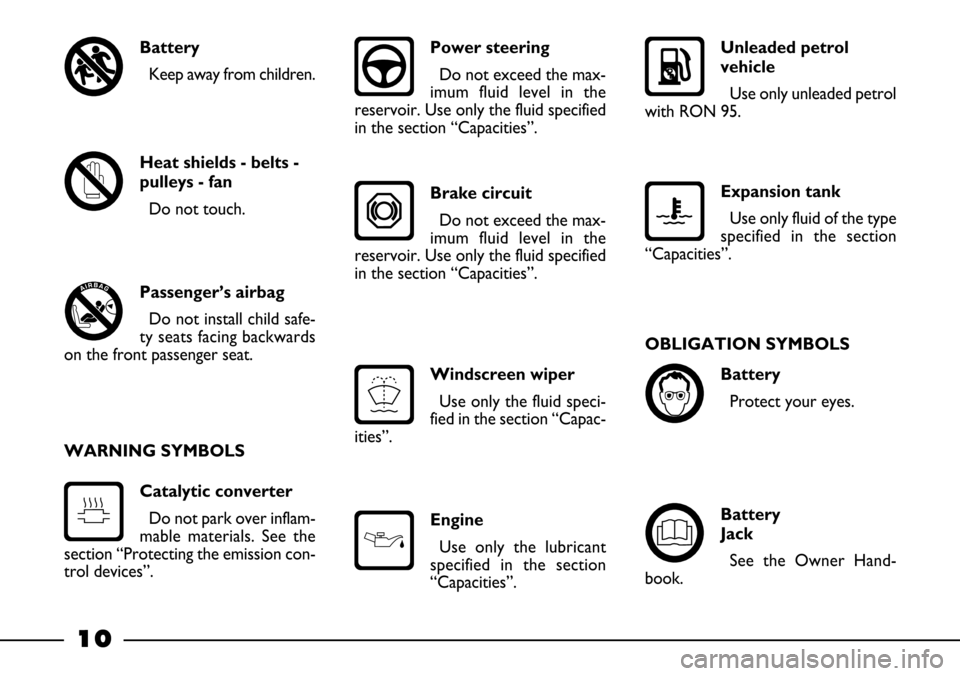
Unleaded petrol
vehicle
Use only unleaded petrol
with RON 95.
Expansion tank
Use only fluid of the type
specified in the section
“Capacities”.
Battery
Jack
See the Owner Hand-
book.Battery
Protect your eyes.
Engine
Use only the lubricant
specified in the section
“Capacities”. Windscreen wiper
Use only the fluid speci-
fied in the section “Capac-
ities”.Brake circuit
Do not exceed the max-
imum fluid level in the
reservoir. Use only the fluid specified
in the section “Capacities”.
Catalytic converter
Do not park over inflam-
mable materials. See the
section “Protecting the emission con-
trol devices”.Power steering
Do not exceed the max-
imum fluid level in the
reservoir. Use only the fluid specified
in the section “Capacities”.
Passenger’s airbag
Do not install child safe-
ty seats facing backwards
on the front passenger seat.Heat shields - belts -
pulleys - fan
Do not touch. Battery
Keep away from children.
10
WARNING SYMBOLSOBLIGATION SYMBOLS
Page 32 of 170
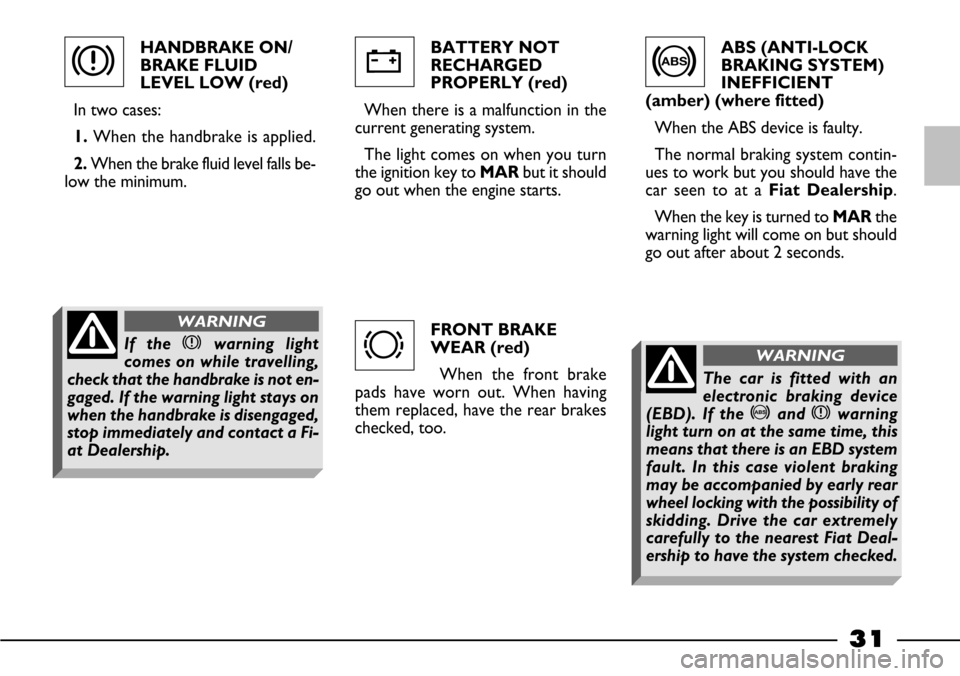
ABS (ANTI-LOCK
BRAKING SYSTEM)
INEFFICIENT
(amber) (where fitted)
When the ABS device is faulty.
The normal braking system contin-
ues to work but you should have the
car seen to at a Fiat Dealership.
When the key is turned toMARthe
warning light will come on but should
go out after about 2 seconds. HANDBRAKE ON/
BRAKE FLUID
LEVEL LOW (red)
In two cases:
1. When the handbrake is applied.
2. When the brake fluid level falls be-
low the minimum.BATTERY NOT
RECHARGED
PROPERLY (red)
When there is a malfunction in the
current generating system.
The light comes on when you turn
the ignition key to MARbut it should
go out when the engine starts.
FRONT BRAKE
WEAR (red)
When the front brake
pads have worn out. When having
them replaced, have the rear brakes
checked, too.
31
w>
d
x
If the xwarning light
comes on while travelling,
check that the handbrake is not en-
gaged. If the warning light stays on
when the handbrake is disengaged,
stop immediately and contact a Fi-
at Dealership.
WARNING
The car is fitted with an
electronic braking device
(EBD). If the >and xwarning
light turn on at the same time, this
means that there is an EBD system
fault. In this case violent braking
may be accompanied by early rear
wheel locking with the possibility of
skidding. Drive the car extremely
carefully to the nearest Fiat Deal-
ership to have the system checked.
WARNING
Page 58 of 170
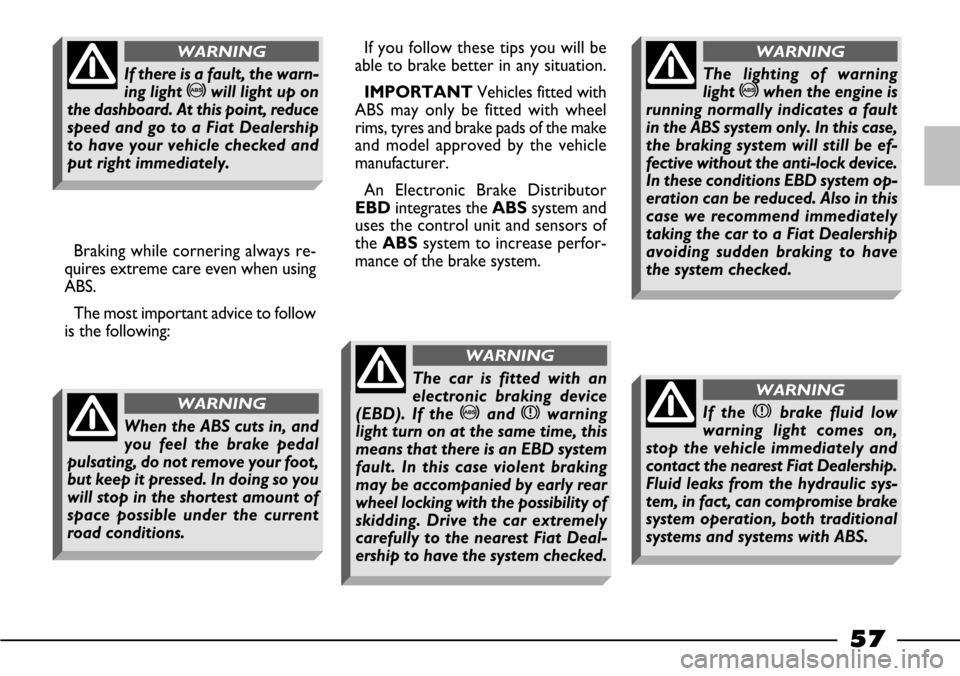
57
Braking while cornering always re-
quires extreme care even when using
ABS.
The most important advice to follow
is the following:If you follow these tips you will be
able to brake better in any situation.
IMPORTANTVehicles fitted with
ABS may only be fitted with wheel
rims, tyres and brake pads of the make
and model approved by the vehicle
manufacturer.
An Electronic Brake Distributor
EBD integrates the ABSsystem and
uses the control unit and sensors of
theABSsystem to increase perfor-
mance of the brake system.
If there is a fault, the warn-
ing light >will light up on
the dashboard. At this point, reduce
speed and go to a Fiat Dealership
to have your vehicle checked and
put right immediately.
WARNING
When the ABS cuts in, and
you feel the brake pedal
pulsating, do not remove your foot,
but keep it pressed. In doing so you
will stop in the shortest amount of
space possible under the current
road conditions.
WARNING
The car is fitted with an
electronic braking device
(EBD). If the >and xwarning
light turn on at the same time, this
means that there is an EBD system
fault. In this case violent braking
may be accompanied by early rear
wheel locking with the possibility of
skidding. Drive the car extremely
carefully to the nearest Fiat Deal-
ership to have the system checked.
WARNING
The lighting of warning
light >when the engine is
running normally indicates a fault
in the ABS system only. In this case,
the braking system will still be ef-
fective without the anti-lock device.
In these conditions EBD system op-
eration can be reduced. Also in this
case we recommend immediately
taking the car to a Fiat Dealership
avoiding sudden braking to have
the system checked.
WARNING
If the xbrake fluid low
warning light comes on,
stop the vehicle immediately and
contact the nearest Fiat Dealership.
Fluid leaks from the hydraulic sys-
tem, in fact, can compromise brake
system operation, both traditional
systems and systems with ABS.
WARNING
Page 83 of 170
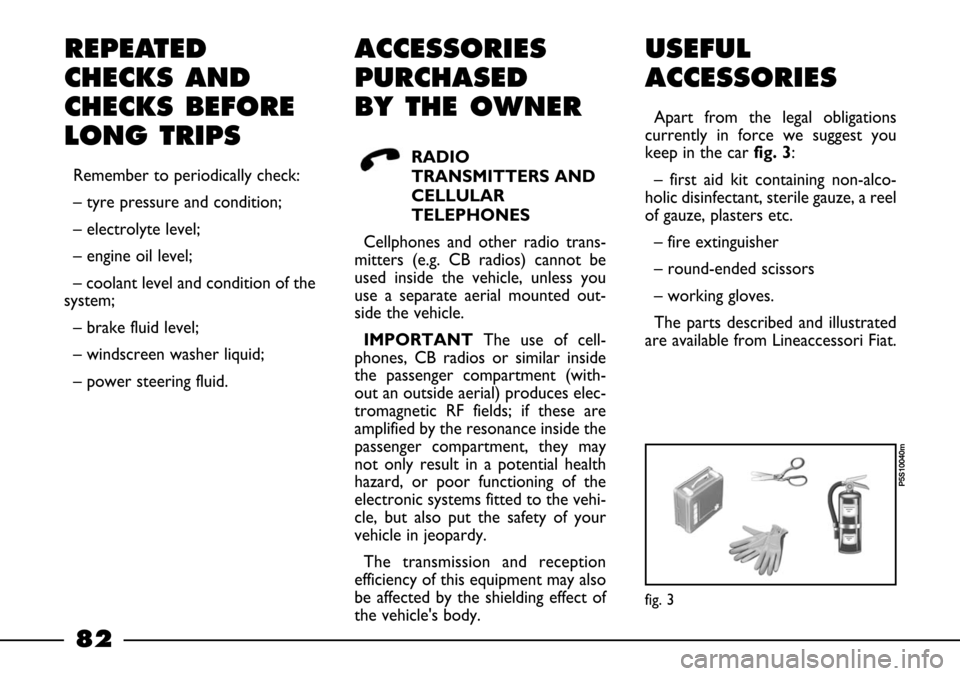
82
REPEATED
CHECKS AND
CHECKS BEFORE
LONG TRIPS
Remember to periodically check:
– tyre pressure and condition;
– electrolyte level;
– engine oil level;
– coolant level and condition of the
system;
– brake fluid level;
– windscreen washer liquid;
– power steering fluid.
ACCESSORIES
PURCHASED
BY THE OWNER
RADIO
TRANSMITTERS AND
CELLULAR
TELEPHONES
Cellphones and other radio trans-
mitters (e.g. CB radios) cannot be
used inside the vehicle, unless you
use a separate aerial mounted out-
side the vehicle.
IMPORTANTThe use of cell-
phones, CB radios or similar inside
the passenger compartment (with-
out an outside aerial) produces elec-
tromagnetic RF fields; if these are
amplified by the resonance inside the
passenger compartment, they may
not only result in a potential health
hazard, or poor functioning of the
electronic systems fitted to the vehi-
cle, but also put the safety of your
vehicle in jeopardy.
The transmission and reception
efficiency of this equipment may also
be affected by the shielding effect of
the vehicle's body.
USEFUL
ACCESSORIES
Apart from the legal obligations
currently in force we suggest you
keep in the car fig. 3:
– first aid kit containing non-alco-
holic disinfectant, sterile gauze, a reel
of gauze, plasters etc.
– fire extinguisher
– round-ended scissors
– working gloves.
The parts described and illustrated
are available from Lineaccessori Fiat.
fig. 3
P5S10040m
Page 115 of 170
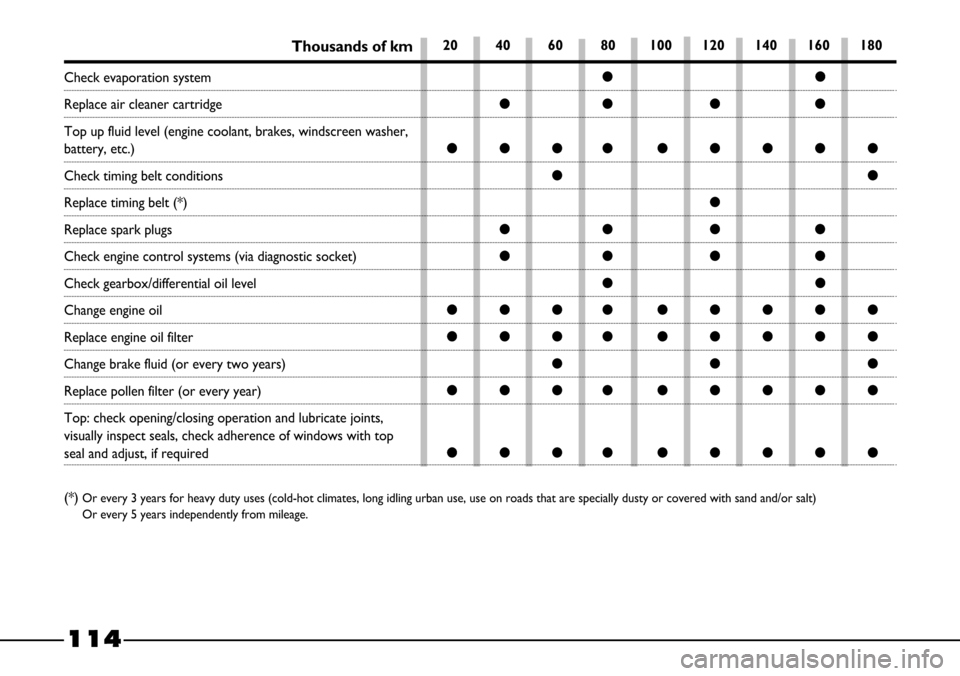
114
(*) Or every 3 years for heavy duty uses (cold-hot climates, long idling urban use, use on roads that are specially dusty or covered with sand and/or salt)
Or every 5 years independently from mileage.
Thousands of km
çç
çç ç ç
çççç ççççç
çç
ç
çç ç ç
çç ç ç
çç
çççç ççççç
çççç ççççç
ççç
çççç ççççç
çççç ççççç
20 40 60 80 100 120 140 160 180
Check evaporation system
Replace air cleaner cartridge
Top up fluid level (engine coolant, brakes, windscreen washer,
battery, etc.)
Check timing belt conditions
Replace timing belt (*)
Replace spark plugs
Check engine control systems (via diagnostic socket)
Check gearbox/differential oil level
Change engine oil
Replace engine oil filter
Change brake fluid (or every two years)
Replace pollen filter (or every year)
Top: check opening/closing operation and lubricate joints,
visually inspect seals, check adherence of windows with top
seal and adjust, if required
Page 116 of 170

115
ANNUAL
INSPECTION
SCHEDULE
The following annual inspection
schedule is required for cars travelling
less than 20,000 km a year (e.g. ap-
proximately 10,000 km). The schedule
includes the following operations:
– Check tyre condition and wear and
adjust pressure, if required (including
spare-saver spare wheel).
– Check operation of lights (head-
lights, direction indicators, hazard
lights, boot light, passenger compart-
ment ceiling light, glove compartment
light, instrument panel lights, etc.).
– Check windscreen wiper/washer
and adjust nozzles.
– Check position wear of windscreen
window wiper blades.
ADDITIONAL
OPERATIONS
Every 1,000 kmor before long
trips, check and top up as necessary:
– coolant level
– brake fluid level
– power steering fluid level
– electrolyte level
– windscreen washer liquid level
– tyre condition and pressure.
We advise you to use FL Selenia
products, which have been designed
and produced expressly for the Fiat
vehicles (see the table “Capacities” giv-
en in the “Technical specifications”
section).
Every 3,000 km check and top up
as necessary: engine oil level. – Check rear brake pad conditions
and wear.
– Inspect conditions of. engine, gear-
box, transmission, piping (exhaust - fu-
el feed - brakes), rubber parts (boots
- sleeves - bushings - etc.), brake and
fuel line hoses.
– Check battery charge status.
– Check conditions of various con-
trol belts.
– Check and top up fluid levels (en-
gine coolant, brakes, windscreen
washer, battery, etc.).
– Change engine oil.
– Replace engine oil filter.
– Replace pollen filter (where fitted).
Page 118 of 170
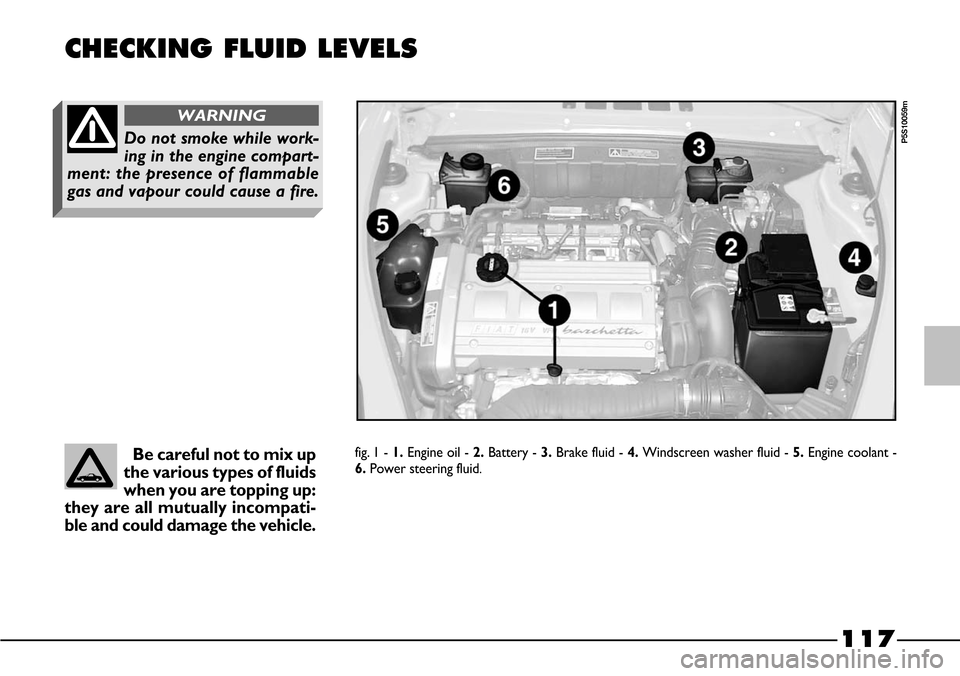
117
CHECKING FLUID LEVELS
P5S10059m
Be careful not to mix up
the various types of fluids
when you are topping up:
they are all mutually incompati-
ble and could damage the vehicle.fig. 1 -1. Engine oil - 2. Battery - 3. Brake fluid - 4. Windscreen washer fluid - 5. Engine coolant -
6. Power steering fluid.
Do not smoke while work-
ing in the engine compart-
ment: the presence of flammable
gas and vapour could cause a fire.
WARNING
Page 122 of 170
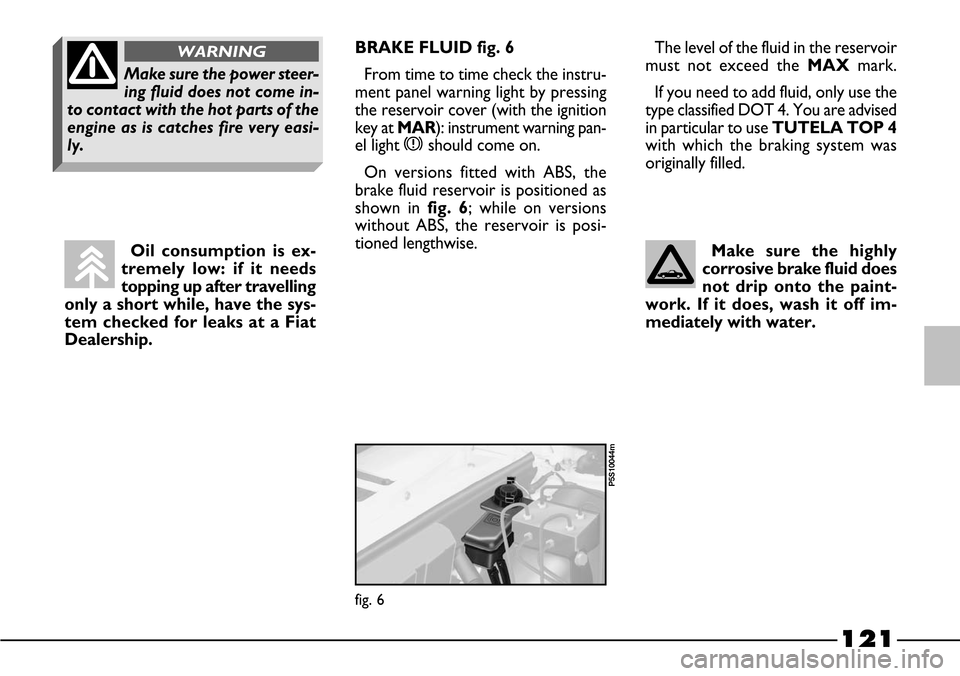
121
Oil consumption is ex-
tremely low: if it needs
topping up after travelling
only a short while, have the sys-
tem checked for leaks at a Fiat
Dealership.
fig. 6
P5S10044m
The level of the fluid in the reservoir
must not exceed the MAXmark.
If you need to add fluid, only use the
type classified DOT 4. You are advised
in particular to use TUTELA TOP 4
with which the braking system was
originally filled. BRAKE FLUID fig. 6
From time to time check the instru-
ment panel warning light by pressing
the reservoir cover (with the ignition
key at MAR): instrument warning pan-
el light xshould come on.
On versions fitted with ABS, the
brake fluid reservoir is positioned as
shown in fig. 6; while on versions
without ABS, the reservoir is posi-
tioned lengthwise.
Make sure the highly
corrosive brake fluid does
not drip onto the paint-
work. If it does, wash it off im-
mediately with water.
Make sure the power steer-
ing fluid does not come in-
to contact with the hot parts of the
engine as is catches fire very easi-
ly.
WARNING
Page 123 of 170
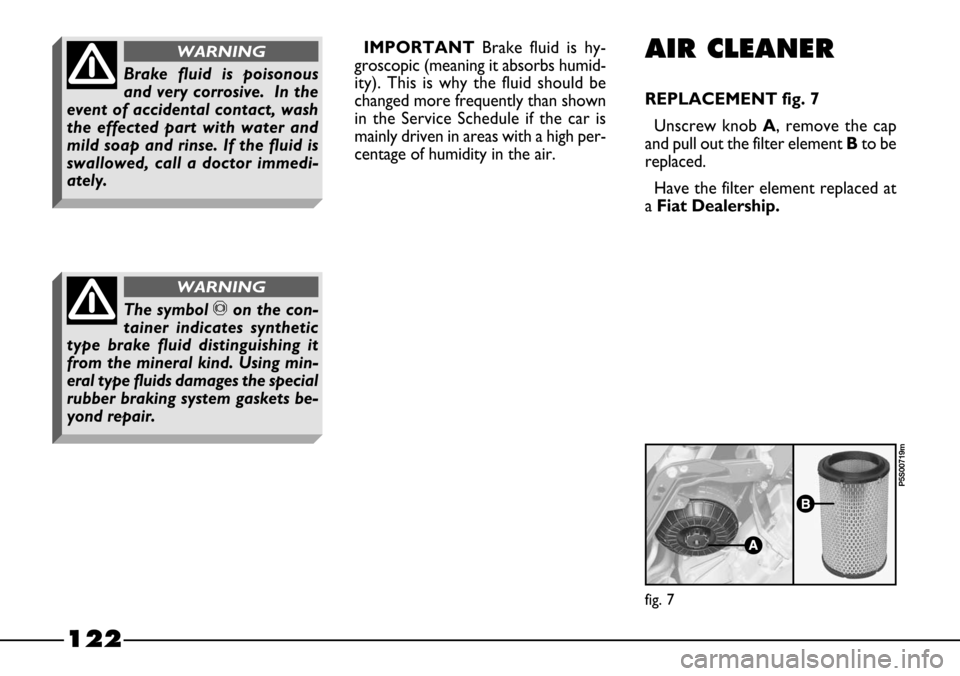
122
IMPORTANT Brake fluid is hy-
groscopic (meaning it absorbs humid-
ity). This is why the fluid should be
changed more frequently than shown
in the Service Schedule if the car is
mainly driven in areas with a high per-
centage of humidity in the air.AIR CLEANER
REPLACEMENT fig. 7
Unscrew knob A, remove the cap
and pull out the filter element Bto be
replaced.
Have the filter element replaced at
a Fiat Dealership.
fig. 7
P5S00719m
Brake fluid is poisonous
and very corrosive. In the
event of accidental contact, wash
the effected part with water and
mild soap and rinse. If the fluid is
swallowed, call a doctor immedi-
ately.
WARNING
The symbol πon the con-
tainer indicates synthetic
type brake fluid distinguishing it
from the mineral kind. Using min-
eral type fluids damages the special
rubber braking system gaskets be-
yond repair.
WARNING
Page 136 of 170
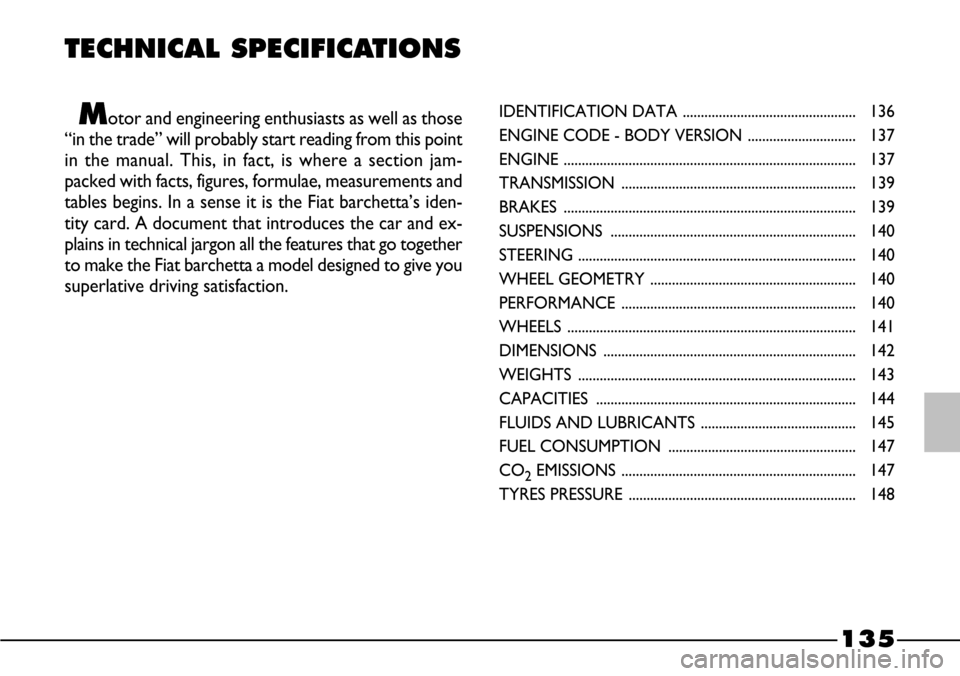
135
TECHNICAL SPECIFICATIONS
Motor and engineering enthusiasts as well as those
“in the trade” will probably start reading from this point
in the manual. This, in fact, is where a section jam-
packed with facts, figures, formulae, measurements and
tables begins. In a sense it is the Fiat barchetta’s iden-
tity card. A document that introduces the car and ex-
plains in technical jargon all the features that go together
to make the Fiat barchetta a model designed to give you
superlative driving satisfaction.IDENTIFICATION DATA ................................................ 136
ENGINE CODE - BODY VERSION .............................. 137
ENGINE ................................................................................. 137
TRANSMISSION ................................................................. 139
BRAKES ................................................................................. 139
SUSPENSIONS .................................................................... 140
STEERING ............................................................................. 140
WHEEL GEOMETRY ......................................................... 140
PERFORMANCE ................................................................. 140
WHEELS ................................................................................ 141
DIMENSIONS ...................................................................... 142
WEIGHTS ............................................................................. 143
CAPACITIES ........................................................................ 144
FLUIDS AND LUBRICANTS ........................................... 145
FUEL CONSUMPTION .................................................... 147
CO
2EMISSIONS ................................................................. 147
TYRES PRESSURE ............................................................... 148